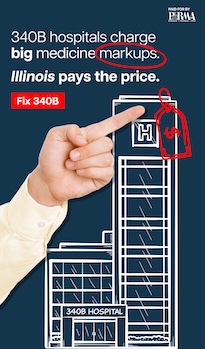At first, hearing that six in ten Illinois voters think the country is headed in the wrong direction, and that two-thirds think the state is headed in the wrong direction, would seem like bad news. However, both numbers—particularly regarding the state of Illinois’ direction—are improvements over last spring’s numbers, according to the latest Simon PollTM, conducted by the Paul Simon Public Policy Institute at Southern Illinois University Carbondale.
While 67 percent said they thought things in the state of Illinois were off track and moving in the wrong direction, that was significantly below the 84 percent who gave “wrong direction” responses in Spring 2018. More than one in five (22 percent) in this year’s survey said things in Illinois were moving in the right direction, compared to just 9 percent last Spring.
About six in ten (61 percent) surveyed this year said things in the United States were off track and moving in the wrong direction, compared with 64 percent in the spring 2018 poll. Three in ten (30%) said things were moving in the right direction, compared with 27 percent a year ago.
The Simon PollTM was based on a statewide sample of 1,000 registered voters conducted March 11 through March 17. The margin of error is plus or minus 3.1 percent.
“Thinking back to a year ago, what changed in Illinois to cause more than one in eight voters to change their minds about the direction of the state?” asked Charlie Leonard, one of the directors of the Simon Poll. “While there has been good economic news here and there, we have to think that a change in state leadership—the decisive victory of Governor J.B. Pritzker over the unpopular former governor, Bruce Rauner—has a lot to do with it, even though Governor Pritzker’s lukewarm approval rating doesn’t look like he’s received much of a ‘honeymoon’ period.”
Significant regional differences surfaced regarding direction of the State of Illinois, with 27 percent of City of Chicago respondents saying the state is headed in the right direction, compared with 22 percent in the Chicago suburbs and 17 percent downstate.
Perhaps representing partisan enthusiasm with the election of a new governor, Democratic respondents were more optimistic about the direction of the state (36 percent “right direction”) than were Independents (14 percent) or Republicans (10 percent).
Regarding the state of the country, “right direction” responses topped 35 percent in Downstate Illinois, followed by 30 percent in the Chicago suburbs and 25 percent in the City of Chicago.
Partisan differences on the direction of the country may also reflect the partisan makeup of executive leadership, with Republicans far more likely to give “right direction” responses (60 percent) than were Independents (27 percent) or Democrats (10 percent).
Typically, respondents are more optimistic about their local communities than they are regarding their state or the country as a whole. In this year’s survey, 56 percent said things in their city or area of the state were moving in the right direction and 35 percent said they were moving in the wrong direction, very similar to last year’s result.
Reform Issues
As in past Simon Institute surveys, support for legislative term limits tops eight voters in ten. This year, 84 percent supported “a proposal limiting the number of years state legislators can serve in the House of Representatives, the State Senate, or a combination of the two,” and 61 percent strongly supported term limits. By contrast, only 13 percent opposed term limits.
Similarly, 85 percent supported leadership term limits, limiting how long legislators could serve in positions such as Speaker of the House or President of the Senate, with 65 percent strongly favoring the proposal. Just one in eight (12 percent) opposed leadership term limits.
Partisan and regional differences on both term limit proposals were minimal, with large majorities in all categories supporting the reforms.
Again, as in past surveys, a proposed constitutional amendment to have legislative district maps created by an independent commission rather than the legislature received two-thirds (67 percent) support, with almost four in ten (38 percent) strongly favoring the reform. Fewer than one in four voters (22 percent) opposed the redistricting proposal.
Whether in Chicago, its suburbs, or downstate, more than six in ten respondents supported the independent redistricting commission. However, while still a solid majority, fewer Republicans supported the redistricting reform (63 percent) than did Independents (70 percent) or Democrats (72 percent).
Minimum Wage Increase
Interviewers asked respondents whether they “support or oppose incremental increases in the state’s minimum wage, with is currently $8.25 an hour, up to $15 per hour, by January 1, 2025.” While minimum wage hikes usually spark controversy, two-thirds (66 percent) of Illinois voters in the Simon Poll sample supported the minimum wage increase—with 49 percent strongly favoring it. About a third (32 percent) opposed the increase in the minimum wage.
Regional differences in support for the minimum wage hike appear, with support highest in Chicago (81 percent), followed by the Chicago suburbs (71 percent) and Downstate Illinois (48 percent). Even stronger partisan differences appear, with nine in ten Democrats (91 percent) supporting the wage increase, as opposed to four in ten Republicans (39 percent). Fifty nine percent of Republicans opposed the minimum wage increase. A solid majority of Independents (58 percent) support the gradual minimum wage increase.
John S. Jackson, one of the directors of the poll, summarized the debate over this issue, “The minimum wage bill was passed by the Illinois General Assembly with strong support from Governor Pritzker. The opposition was led by the Republicans, some business groups, and legislators from downstate. They argued that the increases would cost jobs and that downstate living expenses were less than those in metropolitan Chicago, and thus there should be a two- tiered minimum wage. Supporters argued that the requirements for a ‘living wage’ downstate were often well above what this bill would provide and thus workers there also needed a wage increase to meet those requirements. In addition, supporters pointed out that there is very mixed evidence over whether minimum wage increases lead to job losses. These divisions represent the usual polarization in Illinois and the nation at this point in our history.”
The margin of error for the entire sample of 1,000 voters is plus or minus 3.1 percentage points. This means that if we conducted the survey 100 times, in 95 of those instances, the population proportion would be within plus or minus the reported margin of error for each subsample. For subsamples, the margin of error increases as the sample size goes down. The margin of error was not adjusted for design effects.
Live telephone interviews were conducted by Customer Research International of San Marcos, Texas using the random digit dialing method. The telephone sample was provided to Customer Research International by Scientific Telephone Samples. Potential interviewees were screened based on whether they were registered voters and quotas based on area code and sex (<60 percent female). The sample obtained 54 percent male and 46 percent female respondents. Interviewers asked to speak to the youngest registered voter at home at the time of the call. Cell phone interviews accounted for 60 percent of the sample. A Spanish language version of the questionnaire and a Spanish-speaking interviewer were made available.
Field work was conducted from March 11 to 17. No auto-dial or “robo” polling is included. Customer Research International reports no Illinois political clients. The survey was paid for with non-tax dollars from the Institute’s endowment fund. The data were not weighted in any way.
That’s pretty high on the male end, which is actually good news for Pritzker on the $15 minimum wage question because 73 percent of women support the plan while 59 percent of men back it. If that universe more accurately reflected the usual electorate, the 66 percent overall support would be higher.
Also, while all Downstate Republicans and some Downstate House Democrats opposed the plan, the region was split 48-49 on the new law. And 64 percent of people making over $100K backed the plan as well as 68 percent of those who are age 66 and over. Even 40 percent of conservatives support it.













